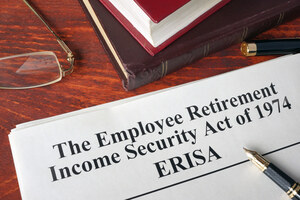 The latest twist in Utah et al. v. Julie Su, Acting Secretary of Labor (formerly captioned Utah v. Walsh) was sparked by the U.S. Supreme Court’s June 28 decision in Loper Bright Enterprises. v. Raimondo. Loper Bright overruled the “Chevron doctrine” of deference to federal agencies.
The latest twist in Utah et al. v. Julie Su, Acting Secretary of Labor (formerly captioned Utah v. Walsh) was sparked by the U.S. Supreme Court’s June 28 decision in Loper Bright Enterprises. v. Raimondo. Loper Bright overruled the “Chevron doctrine” of deference to federal agencies.Loper Bright sent shock waves through the ERISA, employee benefits and executive compensation world. The challenge to ESG investing is likely just the tip of a looming ERISA litigation iceberg.
DOL ESG Rule
ERISA requires plan fiduciaries to act prudently and for the exclusive benefit of participants and beneficiaries. The Prudence and Loyalty in Selecting Plan Investments and Exercising Shareholder Rights Rule, as the DOL’s ESG investing guidance is formally known, permits fiduciaries to consider “the economic effects of climate change” and other factors when making investment decisions, as long as these considerations remain rooted in the typical risk-return analysis. Fiduciaries are allowed to consider these issues as tie-breakers in close decisions.
On their face, neither of these general statements of principle seem likely to cause “hair-on-fire” ERISA lawsuits. But they do, and it’s for one big reason – money.
ERISA retirement plans hold roughly $12 trillion in assets. Environmentally disfavored industries, like the fossil fuel industry, cannot afford to lose that market. The plaintiffs in Utah v. Su include 26 states, including states whose economies depend on fossil fuel production, two energy companies, an energy lobbying group, and one ERISA plan participant, whose sole function it appears, is to establish standing.
The New Challenge
On September 21, 2023, the Northern District of Texas, in an earlier phase of Utah, held that plan fiduciaries could consider environmental, social and governance (ESG) factors in choosing pension plan investments. The decision leans heavily on the Chevron doctrine. It was a surprise, not least of all to the plaintiffs. They appealed to the Fifth Circuit.
On June 28, only hours after the Supreme Court delivered its decision in Loper Bright, Utah’s solicitor general argued to the Fifth Circuit that the overturning of Chevron means the appeals court should reverse the Northern District’s decision on the ESG rule. The plaintiffs were clearly primed and ready. The Fifth Circuit heard the new argument on July 9.
Loper Bright
Loper Bright holds that, under the Administrative Procedure Act, courts should exercise their independent judgment in deciding whether an agency has acted within its statutory authority. Furthermore, courts may not defer to an agency’s interpretation of the law simply because a statute is ambiguous.
These are the questions the Fifth Circuit (and the rest of us) now face:
- Are ERISA’s prudence and exclusive benefit standards ambiguous?
- Does ERISA, as enacted by Congress in 1974, explicitly mention environmental, social and governance factors, including the economic effects of climate change?
- Will the Fifth Circuit conclude that the DOL exceeded its statutory authority in adopting the rule on ESG investing? If so, will the court find that the adoption of the rule was an unlawful exercise of power and cannot stand.
- Does it make sense for the court system, and only the court system, regardless of historical input from the DOL and other agencies charged with administering the law, to determine what ERISA means?
Prognostications
Predicting the future is a foolish and dangerous business. The Fifth Circuit is widely thought to be the most conservative appeals court in the United States. It generated many of the cases heard by the Supreme Court in the past term. The high court reversed the appeals court on several of them.
READ MORE ERISA VIOLATION LEGAL NEWS
With its decision in Loper Bright, however, the Supreme Court seems to have handed the Fifth Circuit the rationale that it may use to strike down any number of regulations designed to protect the rights of employees.
The Supreme Court appears to have moved toward dismantling the power of federal agencies and much of administrative law, including those rules that protect retirement savings and define the obligations of plan sponsors.
Proponents of socially conscious investing wait with bated breath. If the Northern District’s decision in Utah is overturned, the huge sums of retirement savings currently held in trust for ERISA plan participants could become a lucrative market, a tasty treat, for fossil fuel industries. Stay tuned.
